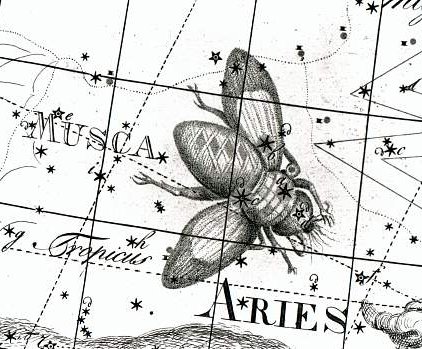Thus I have suggested the dates in Manuscript E were connected not with the present time days but with where the days would have been according to the time-frame of Bharani. Also the Arabs had evidently adopted such a structure, for although we cannot find any Bharani station in their list the fraction 0.4 reveals her presence and domination (up to the Mane of the Lion):
The month names in Manuscript E:
Marama. 1. Month, light. The ancient names of the month were: Tua haro, Tehetu'upú, Tarahao, Vaitu nui, Vaitu poru, He Maro, He Anakena, Hora iti, Hora nui, Tagaroa uri, Ko Ruti, Ko Korķ. 2. Name of an ancient tribe. Maramara, ember. Vanaga. Light, day, brightness, to glimmer; month; intelligent, sensible; no tera marama, monthly; marama roa, a long term; horau marama no iti, daybreak; hakamarama, school, to glimmer; hare hakamarama, school, classroom. P Mgv.: mārāma, the light, daylight; marāma, wise, learned, instructed, moon. Mq.: maáma, light, broad day, bright, instructed, learned; meama, moon, month. Ta.: marama, moon, month. In form conditionalis this word seems derivative from lama, in which the illuminating sense appears in its signification of a torch. The sense of light, and of specifically the moon, appears in all Polynesia; in Futuna and Uvea the word signifies the world. The tropical extension to the light of intelligence is not found in Nuclear Polynesia, therefore not in the Proto-Samoan, but is a later Tongafiti development. Maramarama, bright; manava maramarama, intelligent. P Pau.: maramarama, intelligent. Ta.: maramarama, light, brightness. Churchill. The month sense is found in Tahiti, Marquesas, Rarotonga and Maori associated with the moon signification, and in Hawaii is specifically dissociated therefrom to characterize a solar month. Churchill 2. Hanga Takaure marks the beginning of the Ditch of Fire which separated (severed) the Head of Poike (Place Aloft) from the Main Land.
... Somewhere in The Eighth Land is mentioned that this part of the island was named 'the neck of the turtle'. It makes sense if we think of the turtle as the 'earth turtle' of Easter Island. The high Poike in the east will then be the head of the land and the line of fire across the neck could represent a noose with which the turtle is caught ... |
||||||||||||||||||||||||||||||||||||||||||||||||||||||||||||||||||||||||||||||||||||||||||||||||||||||||||||||||||||||||||

.jpg)